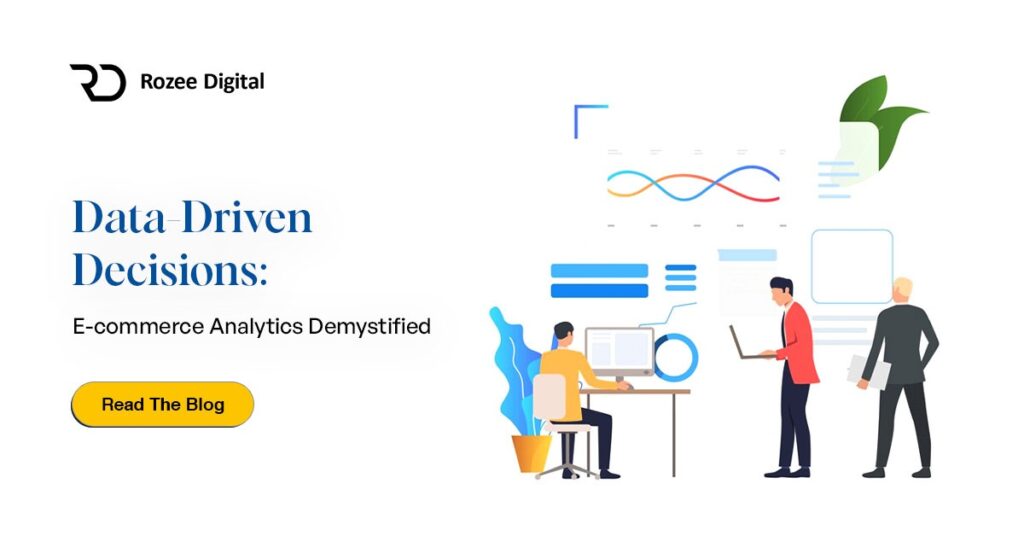In the fast-changing world of e-commerce, where competition is tough and customer tastes change quickly, making the right choices can either lead to success or failure. Imagine having a guide that helps you understand your customers, predict trends, and improve your marketing efforts. This isn’t just a dream; it’s what data-driven decision-making can do for you. Welcome to the world of e-commerce analytics, where data isn’t just a bunch of numbers but a powerful tool to improve your business.
Join us as we break down e-commerce analytics, showing how it can help you make smart decisions, enhance customer experiences, and boost your profits. This blog post seeks to clarify marketing analytics by enlightening key metrics and their importance in achieving marketing success.
Analytics Unveiled: Understanding Essential Metrics for Marketing Success
1. Website Traffic
Pageviews: Pageviews indicate the total number of times a page on your website has been viewed. A higher number suggests greater user engagement.
Unique Visitors: This metric shows the number of distinct individuals who have visited your site, helping assess your reach.
2. Conversion Rate
This measures the percentage of visitors who take a desired action, such as making a purchase or signing up for a newsletter. A higher conversion rate indicates effective marketing strategies.
3. Bounce Rate
This metric shows the percentage of visitors who leave your site after viewing only one page. A lower bounce rate implies better engagement and relevance.
4. Click-Through Rate (CTR)
CTR measures the effectiveness of your ads by indicating the percentage of users who clicked on them. A higher CTR signifies compelling ad content.
5. Customer Acquisition Cost (CAC)
CAC reflects the cost of acquiring a new customer. This metric helps in optimizing marketing budgets.
6. Return on Investment (ROI)
ROI calculates the profitability of your marketing efforts. A positive ROI means your marketing campaigns are generating more revenue than cost.
7. Customer Lifetime Value (CLV)
CLV estimates the total revenue a customer is expected to generate during their relationship with your business. It guides customer retention efforts.
8. Email Marketing Metrics
Open Rate: Open rate measures the percentage of recipients who opened your email, indicating its effectiveness.
Click Rate: The click rate shows the percentage of email recipients who clicked on a link, revealing the engagement level of your email content.
9. Social Media Metrics
Engagement Rate: This gauges how users interact with your social media content, including likes, comments, and shares. Higher engagement indicates a more responsive audience.
Follower Growth: Tracking the growth in your social media followers helps assess the success of your social media strategies.
10. SEO Metrics
Organic Traffic: Organic traffic measures the number of visitors coming to your site from search engines. An increase signifies improved SEO.
Keyword Ranking: Monitoring your website’s ranking for specific keywords shows the effectiveness of your SEO efforts.
A Guide to Data-Driven Decision Making
Nowadays, data is often referred to as the new gold. Businesses across various industries increasingly rely on data-driven decision-making to gain a competitive edge, enhance customer experiences, and drive growth. However, the world of analytics can often seem like a complex labyrinth. This comprehensive guide aims to demystify analytics, making it accessible to individuals and businesses looking to harness its power.
Understanding the Basics: The Analytics
At its core, analytics involves the collection, processing, analysis, and interpretation of data to derive meaningful insights. These insights inform data-driven decisions for business, enabling businesses to make more informed choices about their strategies, operations, and marketing efforts.
Key Concepts and Metrics
1. Descriptive Analytics:
This involves analyzing historical data to gain insights into past performance. It’s the foundation upon which other types of analytics are built.
2. Prescriptive Analytics:
This goes a step further by not only predicting future outcomes but also recommending specific actions to optimize those outcomes, providing actionable insights.
3. Predictive Analytics:
Predictive analytics uses historical data and statistical algorithms to forecast future outcomes. Businesses can use it to anticipate trends and customer behavior.
4. Key Performance Indicators (KPIs):
These are specific metrics that businesses track to measure their performance and progress toward goals. Common marketing KPIs include conversion rates, click-through rates, and customer acquisition costs.
The Benefits of E-commerce Analytics
The internet has revolutionized the way businesses operate. Previously, businesses had to rely on physical locations to sell their products and services. However, with the advent of e-commerce, businesses can now reach a global audience with just a few clicks.
One of the key advantages of e-commerce is the wealth of data it provides, known as e-commerce data driven analytics. This data can be used to make informed decisions about marketing, product development, and other business areas.
E-commerce analytics tracks various data points, such as website traffic, conversion rates, and customer behavior. This data can then be leveraged to enhance overall business performance.
Some of the most notable benefits of e-commerce analytics include:
1. Improved Decision Making
E-commerce analytics helps businesses make better decisions by identifying areas that need improvement and opportunities for growth.
2. Enhanced Customer Experience
This data can be used to improve the overall customer experience by identifying and addressing customer pain points.
3. Increased Sales and Revenue
Analytics can pinpoint areas with growth potential, allowing businesses to capitalize on these opportunities and boost sales and revenue.
4. Cost Savings
E-commerce analytics can help businesses identify areas where they are overspending or where costs can be cut, leading to significant savings.
5. Improved Marketing
Businesses can use analytics to determine which marketing channels are most effective, enabling them to focus on the best-performing channels and increase their marketing ROI.
The Importance of Data-Driven Decision Making
As e-commerce businesses grow, the pressure to make data based decisions intensifies. Making decisions based on data can be the difference between success and failure. Here are several reasons why data driven decision making is crucial:
1. Accuracy
Data-driven decisions are more likely to be accurate because they are based on comprehensive information, ensuring you make informed choices.
2. Efficiency
Making decisions based on data is more efficient than relying on intuition. It eliminates the need for second-guessing and trial and error, saving time and resources.
3. Scalability
As your business grows, the decision-making process becomes more complex. Data-driven decisions are scalable and can handle the increased complexity, unlike intuition-based decisions.
4. Objectivity
Data-driven decisions are more objective as they are not influenced by personal biases or emotions. This ensures that decisions are based solely on factual information.
5. Flexibility
When decisions are based on data, you can easily adapt to new information and situations. This flexibility allows you to change your course of action if the data suggests it, helping you stay responsive to market changes.
Tools for E-commerce Marketing Analytics
There are various tools and platforms available for measuring e-commerce analytics. Some of the key tools include:
1. Google Analytics
Tracks website traffic, user behavior, and conversion metrics, providing valuable insights for e-commerce marketing strategies. It’s a preferred choice due to its integration capabilities with other Google products like Google Ads, offering enhanced insights. Although it’s easy to get started with Google Analytics 4, the abundance of data and metrics can be overwhelming. If you need assistance, our team of Google Analytics specialists is here to help.
2. Kissmetrics
Focuses on customer analytics, offering insights into customer journeys, segmentation, and behavior analysis for targeted marketing efforts.
3. Hotjar
Provides heatmaps, session recordings, and user feedback tools to understand user interactions and improve website usability.
4. Mixpanel
Specializes in event-based analytics, enabling online store owners to track specific user actions and behaviors.
Practical Applications of Analytics across various Domains
Analytics is more than just numbers; it’s about deriving actionable insights. Here are some practical applications across various domains:
- Marketing: Personalizing marketing campaigns, optimizing ad spend, and measuring campaign effectiveness.
- E-commerce: Recommending products to customers based on their browsing history and purchase behavior.
- Finance: Detecting fraudulent transactions and assessing investment risks.
- Healthcare: Predicting patient outcomes and optimizing treatment plans.
Data-Driven E-commerce Marketing Strategies
Online store owners can leverage data-driven strategies to enhance their e-commerce marketing efforts, such as:
1. Segmentation and Personalization
Customize marketing campaigns and offers for specific customer segments to boost engagement and increase conversion rates.
2. A/B Testing
Test different variations of website elements, promotions, and pricing to identify the most effective approaches.
3. Predictive Analytics
Utilize predictive models to forecast customer behavior and anticipate trends, allowing for proactive and strategic marketing initiatives.
4. Real-Time Monitoring
Track e-commerce marketing performance in real-time to make immediate adjustments and optimize campaigns for better results.
Main Challenges and Considerations
While analytics offers immense benefits, it also presents several challenges that businesses need to address to harness its full potential. These include:
1. Data Privacy Concerns
- Regulations and Compliance: Ensuring compliance with data protection re2.gulations such as GDPR and CCPA is critical. Non-compliance can result in hefty fines and damage to a company’s reputation.
- Consumer Trust: Protecting customer data is paramount to maintaining trust. Data breaches or misuse of data can lead to loss of customer confidence and legal repercussions.
2. Data Quality Issues
- Accuracy: Ensuring the data collected is accurate and free from errors is crucial. Inaccurate data can lead to misguided insights and poor decision-making.
- Consistency: Data should be consistent across different sources and over time. Inconsistent data can create confusion and unreliable analysis.
- Completeness: Incomplete data sets can result in gaps in analysis, leading to incomplete insights and potentially flawed conclusions.
3. Need for Skilled Analysts
- Technical Expertise: Skilled analysts with expertise in data science, statistics, and analytical tools are essential for extracting meaningful insights from data.
- Interpretation and Communication: Analysts must not only understand the technical aspects of data but also be able to interpret and communicate findings effectively to stakeholders.
- Continuous Learning: The field of analytics is constantly evolving with new tools, techniques, and best practices. Continuous learning and upskilling are necessary for analysts to stay current and effective.
4. Integration with Existing Systems
- Compatibility: Integrating analytics tools with existing IT infrastructure can be challenging. Ensuring compatibility and smooth data flow between systems is essential.
- Scalability: As data volumes grow, systems need to be scalable to handle increased data loads without performance degradation.
5. Cost and Resource Allocation
- Investment: Implementing advanced analytics solutions can require significant financial investment in tools, technology, and talent.
- Resource Management: Allocating sufficient resources, including time and personnel, to manage and maintain analytics systems is crucial for long-term success.
6. Data Interpretation and Actionability
- Contextual Understanding: Interpreting data correctly requires a deep understanding of the business context and the ability to differentiate between correlation and causation.
- Actionable Insights: Transforming data into actionable insights that drive strategic decisions can be challenging. It requires a clear understanding of business goals and the ability to translate insights into practical actions.
Making the Most of E-commerce Analytics
As the e-commerce landscape evolves, so does the way businesses collect and utilize data. To stay competitive, it’s increasingly important for e-commerce businesses to make data-driven decisions.
Various e-commerce data driven analytics tools offer unique insights, allowing businesses to track metrics such as website traffic, conversion rates, and customer behavior. However, simply collecting data is not enough. To fully leverage e-commerce analytics, businesses need to know how to interpret the data and use it to inform their decision-making.
Here are a few tips for making the most of e-commerce analytics:
1. Identify Your Goals
Before making data-driven decisions, clearly define your business goals. What do you want to achieve with your e-commerce website? Identifying your goals ensures that you’re tracking the right metrics and focusing on data that is most relevant to your business.
2. Understand Your Data
Gain a solid understanding of the data you’re working with. Know what different metrics mean and how they can be interpreted. If unsure about something, seek help from online resources or forums to better utilize e-commerce analytics.
3. Experiment and Test
Experiment with different marketing strategies to see how they impact your metrics. Split testing allows you to compare different versions of your website, while A/B testing can determine which product pages convert better. This helps in finding the most effective approaches for your business.
4. Make Data-Driven Decisions
Once you’ve collected and analyzed your data, start making decisions based on it rather than intuition. Data-driven decisions are more likely to be accurate, efficient, and scalable, leading to better overall outcomes for your e-commerce business.
E-commerce analytics plays a crucial role in the success of modern businesses. It involves collecting, analyzing, and interpreting data to make informed, data-driven decisions.
Empowering Decision-Making with Analytics
Analytics is not a mystical art but a practical tool that empowers individuals and organizations to make informed decisions. Whether you’re a marketer seeking to optimize your campaigns or a business leader looking to gain a competitive edge, understanding analytics is the first step toward leveraging its immense potential. With the right knowledge and tools, you can harness data to drive success and innovation in your endeavors.
Conclusion
Data in decision-making and business serves as the compass that guides us forward. As we conclude our journey through “Analytics Demystified: A Comprehensive Guide to Data-Driven Decision Making,” it becomes clear that data is not an enigma to be feared but a powerful ally to be embraced. By demystifying analytics, you unlock the ability to make smarter decisions, drive growth, and stay ahead of the competition.
FAQs: Analytics Demystified – A Comprehensive Guide to Data-Driven Decision Making
1. What is data-driven decision making?
Data-driven decision making involves using data analysis and insights to guide and inform business decisions. It relies on factual information rather than intuition or guesswork, aiming to enhance accuracy and effectiveness in decision-making processes.
2. Can small businesses benefit from analytics?
Yes, small businesses can benefit significantly from analytics by gaining insights into customer behavior, optimizing marketing efforts, and improving operational efficiency.
3. Why are data-driven decisions important for businesses?
Data-driven decisions are crucial because they help businesses make more accurate and informed choices, improve efficiency, reduce risks, and identify opportunities for growth. By leveraging data, companies can base their strategies on empirical evidence rather than assumptions.
4. What is the data-driven decision-making process?
The data-driven decision-making process involves several steps: defining objectives, collecting and cleaning data, analyzing data to uncover patterns and trends, interpreting the results, and making decisions based on the insights obtained. This process helps ensure decisions are grounded in accurate and relevant information.
5. How to Use Data to Make Decisions
Collect relevant data from sources like sales reports and customer feedback. Analyze and interpret the data to identify patterns and trends. Use these insights to guide strategic decisions, such as optimizing marketing campaigns or improving customer experience. Continuously monitor and adjust based on new data.




